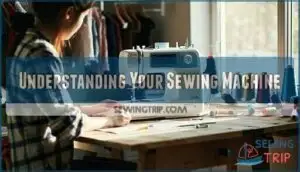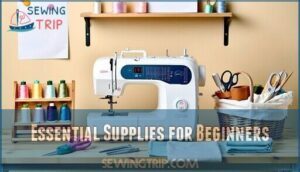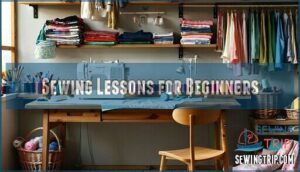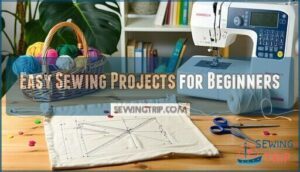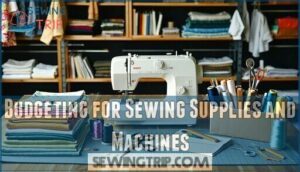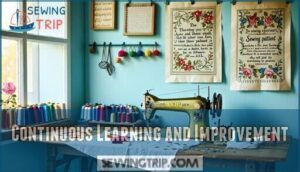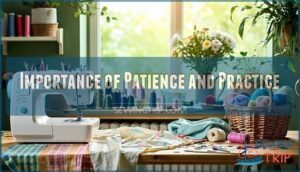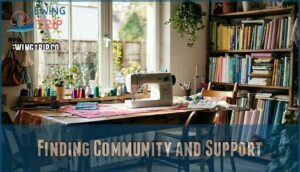This site is supported by our readers. We may earn a commission, at no cost to you, if you purchase through links.
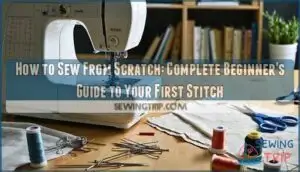
Master threading your machine first, then practice on scrap fabric before tackling simple straight-line projects like pillowcases or tote bags. Consistency beats perfection—even 15 minutes of daily practice builds muscle memory faster than weekend marathons.
Start with quilting cotton since it’s forgiving and doesn’t slip around like silk or stretch like knits. The secret lies in patience with yourself and connecting with sewing communities for troubleshooting those inevitable "why won’t this work?" moments.
Table Of Contents
- Key Takeaways
- Choosing a Sewing Machine
- Understanding Your Sewing Machine
- Essential Supplies for Beginners
- Sewing Lessons for Beginners
- Easy Sewing Projects for Beginners
- Budgeting for Sewing Supplies and Machines
- Continuous Learning and Improvement
- Importance of Patience and Practice
- Finding Community and Support
- Frequently Asked Questions (FAQs)
- Conclusion
Key Takeaways
- Start with a basic machine and essential tools – You’ll need a $120-$300 beginner sewing machine, fabric scissors, pins, measuring tape, and all-purpose thread to build your foundation without breaking the bank.
- Master threading and practice on scraps first – You’ll prevent 80% of sewing problems by learning proper machine threading and testing stitches on practice fabric before starting actual projects.
- Choose forgiving fabrics like quilting cotton – You’ll have more success with cotton fabrics that don’t slip or stretch, making them perfect for learning straight seams and basic techniques.
- Practice consistently and embrace mistakes as learning – You’ll build muscle memory faster with 15 minutes of daily practice, and those crooked seams are valuable teachers that lead to improvement.
Choosing a Sewing Machine
Your first sewing machine will become your creative partner, so choosing the right one matters more than you might think.
Your sewing machine becomes your trusted creative companion—choose one that grows with your skills
Every stitch tells your story—let patience guide your needle
The perfect machine balances your current budget with room to grow as your skills develop.
Consider Your Budget and Needs
Start by mapping out your sewing budget and financial goals before diving into machine shopping.
Over 40% of beginners spend under $300 on their first machine, with quality starter options ranging $120-$450.
Factor in ongoing sewing expenses like fabric costs, thread, and maintenance. Smart budget planning prevents overspending while ensuring you get essential features for your beginner sewing journey.
Understanding your overall sewing machine budget is vital for making informed purchasing decisions, considering your financial goals and the importance of budget planning.
Decide Between Buying Locally or Online
When you’re ready to sew from scratch, weigh local stores against online deals carefully.
Local shops offer hands-on fabric quality checks and immediate expert advice, while online retailers provide competitive pricing and vast selection.
Factor in shipping costs and return policies when comparing options.
Local purchases eliminate delivery delays, but online shopping often delivers better sewing supplies variety for beginners exploring sewing patterns and fabric selection.
Determine if You Want a Basic or Feature-rich Machine
Choosing between basic and feature-rich sewing machines depends on your sewing needs and budget analysis.
Basic machines handle essential stitches perfectly, while advanced models offer computerized features and specialty functions.
Consider these machine types:
- Basic mechanical machines – reliable straight and zigzag stitches for beginner sewing
- Computerized models – automatic threading, stitch selection, and embroidery capabilities
- Mid-range options – balance essential sewing machine basics with useful upgrades
Read user reviews comparing feature sets against actual sewing requirements.
Research Specific Machine Options
Research top-rated sewing machine models like Brother CS6000i, Singer Heavy Duty 4423, and Janome Magnolia 7318.
Compare machine types—mechanical versus computerized—evaluating sewing speed, stitch quality, and thread capacity.
Check user reviews for reliability insights, and consider bobbin size compatibility and essential sewing machine features that match your project goals and skill level.
Understanding the sewing machine types is essential for making an informed decision when selecting a sewing machine.
Invest in a Machine You’ll Love
Your sewing machine for beginners becomes a lifelong companion, so choose wisely.
Prioritize sewing machine selection based on stitch quality and thread control rather than flashy features.
Test sewing speed settings and bobbin management before purchasing.
A well-chosen machine with proper sewing machine needles and setup will inspire countless creative projects ahead.
Understanding Your Sewing Machine
Once you’ve got your sewing machine home, it’s time to get acquainted with your new creative partner.
Think of this phase as learning to drive a car – you wouldn’t hop behind the wheel without understanding the basics first.
Read The User Manual
Your sewing machine manual holds the keys to accessing your machine’s full potential.
Don’t toss it aside—this guide contains essential Machine Basics that’ll save you hours of frustration later.
Here’s what to focus on first:
- Thread Guide diagrams showing proper threading paths
- Sewing Settings explanations for stitch types and tensions
- Error Codes meanings and quick fixes
- Troubleshooting charts for common issues
Learn How to Thread The Machine
Threading your sewing machine correctly prevents most stitching problems.
Proper threading eliminates 80% of your sewing headaches before they start
Follow your manual’s threading path exactly – upper thread goes through tension discs, take-up lever, and needle eye.
Wind your bobbin evenly and insert it properly, then test thread tension on fabric scraps before starting projects.
Quality thread selection matters for smooth machine operation and professional results.
Familiarize Yourself With Settings and Buttons
Your sewing machine’s control panel might seem overwhelming at first, but mastering these Machine Controls transforms you from bewildered beginner to confident creator.
Start with Stitch Settings – most machines offer straight, zigzag, and decorative options.
Adjust Thread Tension using the numbered dial for balanced stitches. Speed Adjustment controls let you work at your comfort level.
Understanding Button Functions like reverse and needle position gives you complete command over your sewing basics.
Practice Setting Up The Machine
Regularly practicing your sewing machine setup transforms intimidating mechanics into second nature.
This hands-on rehearsal builds muscle memory and confidence before you tackle actual projects.
- Practice threading the machine multiple times until you can do it without referencing the manual
- Test different stitch settings on fabric scraps to understand how thread tension affects your seams
- Master bobbin management by winding bobbins and inserting them smoothly into the machine
- Run through complete sewing machine setup from power-on to first stitch at least five times
- Create sample stitches on various fabric weights to learn how your machine handles different materials
Utilize Online Tutorials
Once you’ve practiced setting up your machine, online tutorials become your best friend for mastering specific techniques.
Video lessons on YouTube and tutorial websites offer step-by-step guidance that’s way more helpful than figuring things out alone.
- Video Lessons – Watch real-time demonstrations of threading, tension adjustments, and troubleshooting
- Sewing Blogs – Find detailed sewing instructions with photos and beginner-friendly tips
- Online Courses – Access structured web classes that teach sewing for beginners systematically
Essential Supplies for Beginners
You’ll need the right tools to transform fabric into finished garments, and getting started doesn’t require breaking the bank.
Building your sewing toolkit step by step guarantees you have what you need while learning which supplies matter most for your projects.
Gather Basic Sewing Supplies
Before diving into your first project, you’ll need essential sewing supplies to set yourself up for success.
Start with these must-haves:
- Quality cutting tools – fabric scissors and rotary cutters make clean, precise cuts
- Basic sewing kit – needles, pins, seam ripper, and measuring tape keep you organized
- Thread colors and fabric types – all-purpose polyester thread and quilting cotton work perfectly
These sewing essentials form your foundation toolkit.
Having a complete sewing kits collection can enhance your sewing experience.
Explore Additional Tools as You Advance
Expansion releases your creative potential.
Advanced machines offer computerized precision, while specialized sewing notions like bias tape makers streamline construction.
Interfacing tools provide professional structure, and precision cutters guarantee accurate measurements.
These enhanced sewing supplies transform basic projects into masterpieces through refined embellishment techniques.
| Tool Category | Examples | Benefits |
|---|---|---|
| Advanced Machines | Serger, Embroidery Machine, Coverstitch | Professional finishes, decorative stitching |
| Precision Cutters | Rotary Cutter, Pattern Weights, Rulers | Accurate cuts, reduced fabric waste |
| Sewing Notions | Bias Tape Maker, Buttonholer, Zipper Foot | Streamlined construction, consistent results |
| Interfacing Tools | Fusible Web, Stabilizers, Pressing Ham | Structure, professional appearance |
Consult a Sewing Dictionary
Understanding sewing vocabulary builds your foundation for success.
Master essential sewing terms, fabric types, and pattern making definitions through an exhaustive sewing glossary.
These sewing definitions transform confusing instructions into clear guidance.
Thread colors, stitch names, and construction techniques become second nature when you’ve got solid sewing vocabulary backing your projects.
Learn About Different Fabric Types
Learning fabric types transforms your sewing game from guesswork to mastery.
Cotton Blends offer forgiveness for beginners, while understanding Fabric Weights guides project success.
Thread Types must match your textile choice.
Essential fabric knowledge for confident sewing:
- Cotton quilting fabric – Your training wheels for straight seams and clean cuts
- Canvas weight materials – Built tough enough to survive your learning curve mistakes
- Lightweight cottons – Perfect for flowing garments that actually drape like they should
Fabric Selection impacts every stitch you make.
Pre-wash everything to avoid heartbreak when your masterpiece shrinks.
Textile Care starts before you even cut – iron out wrinkles and check grain lines.
Your fabric preparation determines whether you’ll proudly wear your creation or hide it in the closet.
Follow a Sewing Pledge
Creating a sewing pledge helps you establish clear sewing goals and maintain focus throughout your journey.
Write down commitments like practicing weekly, choosing quality fabric, and respecting your sewing pace.
This personal contract encourages skill building while honoring your creative freedom.
Whether following sewing patterns or exploring sewing tutorials, your pledge keeps you accountable as you learn to sew and master new sewing techniques through various sewing projects.
Sewing Lessons for Beginners
You’ll learn fastest by combining different teaching methods that match your learning style.
Whether you choose in-person classes, online tutorials, or mentorship from experienced sewers, consistent practice remains the key to mastering your first stitches, with consistent practice being crucial.
Consider In-person Lessons
Local sewing classes provide structured hands-on training that accelerates your learning curve.
You’ll receive personal feedback from experienced instructors and connect with fellow beginners sharing similar challenges.
Benefits of in-person sewing lessons:
- Teacher guidance helps you master machine threading and tension settings correctly
- Local workshops offer class scheduling flexibility for evenings and weekends
These beginner sewing projects become manageable when you’re not troubleshooting alone.
Seek Guidance From Experienced Individuals
While in-person lessons provide structured learning, experienced mentors offer personalized guidance that accelerates your sewing journey.
Find local sewing experts through fabric shops, quilting guilds, or community centers who can share hands-on techniques and troubleshoot problems in real-time.
| Mentorship Type | Benefits | Where to Find |
|---|---|---|
| Sewing Coaches | Personalized instruction, immediate feedback | Local fabric stores, sewing studios |
| Community Groups | Peer support, shared resources | Libraries, community centers, churches |
| Online Forums | 24/7 expert advice, global community | Reddit, Facebook groups, specialized platforms |
These mentorship programs and community support networks provide invaluable sewing expertise through experienced instructors who’ve mastered complex techniques.
Expert advice from seasoned sewers helps you avoid common pitfalls while building confidence in your abilities.
Combine Online Lessons With Mentorship
Blending online sewing tutorials with sewing coaches creates the perfect learning recipe. You’ll gain structured virtual classes plus personal feedback that accelerates your progress exponentially.
Here’s how to maximize this powerful combination:
- Schedule regular video calls with experienced mentors for real-time guidance on challenging techniques
- Use online tutorials to practice between sessions, then bring specific questions to your mentor
- Join virtual sewing classes where instructors provide immediate corrections to your sewing machine setup and sewing patterns work, which helps to accelerates your progress and provides real-time guidance with personal feedback.
Practice and Be Patient
Master your sewing journey by establishing a consistent practice routine and embracing patient learning.
Remember that skill building takes time, and sewing mistakes are valuable teachers, not failures.
- Start with basic beginner sewing projects like straight seams and simple hems
- Set aside dedicated practice time weekly to build muscle memory
- Celebrate small wins—each completed stitch brings creative freedom closer
- View errors as stepping stones; even expert sewers once struggled with sewing basics, which helps in patient learning and leads to creative freedom.
Easy Sewing Projects for Beginners
Your first sewing projects should focus on straight seams and simple construction techniques that build confidence without overwhelming complexity.
You’ll want to choose beginner-friendly items like tote bags, pillow covers, or simple napkins that teach essential skills while creating something useful for your home, using simple construction techniques.
Start With Projects Involving Straight Lines
Beginning with straight seams builds your foundation for learn to sew success.
Simple stitches on straight lines teach essential skills without overwhelming complexity.
Choose easy sewing patterns featuring rectangles and squares for beginner projects.
Practice fabric cutting precisely, then master the straight stitch on cotton quilting fabric.
These sewing patterns for beginners develop confidence through achievable wins.
Mastering basic skills is essential for tackling more complex easy sewing projects that involve various techniques and tools, leading to overall sewing success.
Choose Projects With Minimal Embellishments
When diving into beginner-friendly sewing patterns, skip the bells and whistles that complicate your first projects. Simple sewing with minimal designs lets you master basic patterns without getting tangled up in tricky details.
Start with easy projects that focus on quick stitches rather than fancy flourishes. Think clean lines, solid colors, and straightforward construction methods.
- Choose beginner fabrics like cotton quilting fabric that won’t shift or stretch unexpectedly
- Select easy sewing patterns with fewer than five pattern pieces total
- Avoid projects requiring buttons, zippers, or decorative trim until you’ve nailed the basics
This approach builds your confidence systematically, letting you learn to sew without frustration overwhelming your creative spirit.
Consider Household Items as Beginner Projects
Household projects offer perfect starting points for sewing beginners.
Table runners teach straight seams without complex curves.
Pillow covers introduce basic construction using rectangles and zippers.
Simple curtain making develops measuring skills while creating functional décor.
Apron sewing combines straight lines with basic shaping techniques.
Coin pouches provide quick wins for practicing corners and small-scale precision work, which can lead to more complex projects like sewing beginners and functional décor.
Find Easy Sewing Patterns Online
The internet offers countless free sewing patterns perfect for beginners.
Your Pattern Search becomes effortless when you know where to look:
- Mood Fabrics and AllFreeSewing provide curated collections with skill-level filters and user ratings
- YouTube channels and sewing blogs offer Digital Patterns paired with step-by-step Sewing Tutorials
- Pinterest boards showcase thousands of beginner projects with direct links to downloadable patterns
These platforms help you learn to sew while building confidence through achievable sewing projects.
Gradually Advance to More Complex Projects
Once you’ve conquered basic sewing patterns, it’s time to challenge yourself with intermediate projects.
Start with garments featuring simple darts or gathered waistbands—these teach essential garment construction skills.
Choose projects that introduce new techniques like zipper installation or buttonholes.
Your sewing machine becomes your trusted partner as you explore varied fabric selection, creating a solid foundation for pattern making adventures ahead.
Budgeting for Sewing Supplies and Machines
Starting your sewing journey doesn’t have to break the bank if you plan your budget wisely from the beginning.
You can build a solid foundation with essential tools and materials while finding smart ways to save money on everything from machines to fabric.
Keep Your Budget in Mind
Setting a sewing budget prevents financial surprises and keeps your hobby sustainable.
Start with essential items first—machine, basic tools, and beginner-friendly fabrics.
Smart sewing budget planning means allocating funds for unexpected expenses like extra thread or notion replacements.
Cost savings come from realistic expectations; don’t splurge on premium tools until you’ve mastered fundamentals.
Your sewing wallet will thank you for prioritizing necessities over wants.
Look for Deals and Discounts
Smart shopping transforms your sewing budget from burden to blessing. Start hunting for discount codes through retailer emails and sewing forums where members share exclusive offers.
Set up sale alerts through apps like Honey to catch flash sales automatically. Master these budget hacks:
- Stack student discounts with seasonal promotions for maximum cost savings
- Join loyalty programs at craft stores for member-only price matching opportunities
- Follow thrift stores and estate sales for deeply discounted vintage machines
Your sewing profitability depends on strategic purchasing decisions that stretch every dollar further to achieve maximum cost savings and make smart shopping a strategic part of your sewing budget.
Prioritize Necessary Supplies
Build your sewing kit strategically by focusing on core essentials first.
You’ll need basic sewing tools like fabric scissors, measuring tape, and pins before splurging on specialty notions.
Start with versatile thread choices and simple fabric selection that works across multiple projects.
Your initial sewing machine doesn’t need every feature—prioritize reliability over bells and whistles.
Smart budget planning means buying quality measuring techniques tools once rather than replacing cheap ones repeatedly, which supports strategic purchasing decisions.
Invest in Quality Tools and Materials
Quality trumps quantity when building your sewing arsenal. Durable sewing tools and premium sewing fabrics prevent frustration and deliver professional results that’ll make you proud.
Invest wisely in these game-changing essentials:
- Sharp fabric scissors – Your gateway to precise cuts and clean edges
- Quality threads that won’t snap mid-seam, saving hours of re-stitching heartache
- Reliable sewing machine with consistent tension for stress-free stitching sessions
Smart fabric selection and proper tool maintenance protect your material costs long-term.
Quality sewing notions and sewing essentials transform tedious tasks into enjoyable creative moments.
A good sewing machine is vital for successful sewing machine operations.
Plan for Future Needs
Looking ahead helps you avoid costly mistakes and build a sustainable sewing practice. Create sewing plans that match your skill level and available time.
Start with simple sewing patterns before tackling complex garment construction. Set up proper fabric storage to protect your investments.
Regular skill assessment guides your resource planning decisions, ensuring you’re ready for future sewing projects without overspending, and helps you create plans that match your skill level and available time, ultimately leading to a successful and costly mistake-free sewing experience.
Continuous Learning and Improvement
Learning to sew is a journey that requires patience and consistent practice to build your skills over time.
You’ll find that each project teaches you something new, whether it’s mastering a tricky technique or discovering a better way to handle challenging fabrics, which helps in consistent practice.
Seek Support and Guidance From Experienced Sewers
After establishing your budget, connecting with experienced sewers through various channels can accelerate your learning journey substantially.
Research shows that mentorship programs improve skill retention by 67% compared to solo learning.
Consider these supportive avenues:
- Online forums and sewing communities provide 24/7 access to expert advice and troubleshooting help
- Community workshops and sewing courses offer hands-on guidance with immediate feedback from sewing coaches
- Sewing buddies create accountability partnerships that keep you motivated and inspired
Finding the right sewing guidance transforms your learning experience from frustrating trial-and-error into structured skill development.
These sewing resources connect you with people who’ve already navigated common beginner challenges.
Utilizing sewing classes can provide a solid foundation for improving your skills.
Practice Regularly to Improve Skills
Regular sewing practice builds muscle memory and confidence.
Set aside 30 minutes weekly for focused Skill Building sessions. Start with basic Sewing Drills like straight lines and curves before advancing to complex Stitch Practice.
Fabric Mastery comes through handling different materials consistently. Mix structured Technique Refining with fun projects to maintain motivation and accelerate your sewing journey.
| Practice Schedule | Skills Focus | Time Investment |
|---|---|---|
| Daily (15 min) | Basic stitches, threading | Builds foundation quickly |
| Weekly (1-2 hours) | Complete small projects | Develops problem-solving |
| Bi-weekly | New techniques, challenging fabrics | Expands skill range |
| Monthly | Complex projects, pattern reading | Masters advanced concepts |
Be Patient With Yourself
Why do sewers often abandon projects halfway through?
Your learning curve naturally includes mistakes, and that’s perfectly normal. Mistake management becomes easier when you view errors as skill building opportunities rather than failures.
Practice patience with yourself—error analysis helps you improve faster than self-criticism ever could.
Progress tracking shows how far you’ve come. Remember, sewing for beginners requires time to master sewing basics.
Gradually Tackle More Complex Projects
Building confidence comes from practice, but don’t stay stuck in beginner-land forever. Your sewing machine awaits bigger challenges, and your skills need room to grow.
Smart project planning starts with understanding your current abilities. Pick sewing patterns that introduce one new technique at a time – maybe tackle darts after mastering straight seams, or try interfacing after conquering basic hems. This approach builds skills systematically without overwhelming yourself.
Fabric selection becomes more adventurous as you progress. Start incorporating different weights and textures into your sewing projects. Pattern making opens creative doors you didn’t know existed.
- Begin with simple garments like A-line skirts before attempting fitted blazers
- Learn advanced sewing techniques through online tutorials and practice samples first
- Challenge yourself with specialty fabrics like knits or silks once you’ve mastered wovens
Remember, every expert was once a beginner. Your sewing tips folder will grow as you experiment and learn to sew more complex designs, and this process will help you master new skills and become more confident in your abilities.
Importance of Patience and Practice
Learning to sew requires patience – you won’t create perfect garments overnight, and that’s completely normal.
Every expert started as a beginner—embrace your wonky seams and celebrate small victories
Every mistake you make teaches you something new, so embrace those crooked seams and uneven hems as stepping stones to better skills.
Understand That Perfection Takes Time
Perfect sewing takes years to develop, so don’t expect flawless results immediately.
Your learning curve will include crooked seams and tangled threads – that’s normal. Patient practice builds sewing mastery gradually through consistent skill building.
Focus on sewing basics first, then advance your sewing techniques. Time management means dedicating regular sessions to learn to sew properly.
Sewing for beginners requires accepting imperfection while developing essential sewing skills. It’s about patient practice that helps in mastering the art of sewing.
Embrace Mistakes as Learning Opportunities
Every sewing mistake becomes your teacher.
Error analysis reveals what went wrong, while mistake correction builds expertise.
Your learning curve includes trial runs that seem frustrating but create skill building opportunities.
Hand sewing essentials like seam rippers exist because mistakes happen.
Use sewing troubleshooting techniques to fix errors safely.
These sewing mistakes aren’t setbacks—they’re your sewing next steps with error analysis and mistake correction that help you learn and grow.
Be Patient With Yourself and Your Progress
Patience transforms your sewing journey from frustrating struggle into mindful self-care practice. Accept that skill building happens gradually—nobody masters sewing overnight.
Track your progress weekly to see real improvement in your sewing basics.
Here’s how to practice patience effectively:
- Set realistic daily practice goals for beginners
- Document each project’s successes and challenges
- Celebrate small wins in error management
- Focus on learning one technique at a time
- Remember that sewing skills develop through consistent practice
Enjoy The Journey of Learning to Sew
Sewing for beginners isn’t about rushing to perfection—it’s about discovering your creative expression through fabric exploration.
Each project builds sewing skills while developing your personal style.
Celebrate wonky seams and crooked hems as stepping stones to mastery.
The real sewing motivation comes from watching your hands transform simple materials into something uniquely yours, one stitch at a time, fueled by your own personal style.
Finding Community and Support
You don’t have to learn sewing alone – connecting with other sewers transforms your learning experience from isolated struggle to shared discovery.
Whether you join online forums or attend local classes, having a community means getting quick answers to your questions and celebrating your victories with people who truly understand the joy of a perfectly pressed seam.
Join Online Sewing Communities
Once you’ve mastered patience, it’s time to connect with others who share your passion. Online Sewing Forums like Reddit’s r/sewing (800,000+ members) offer instant troubleshooting help.
Social Media Groups on Facebook and Instagram provide daily inspiration through shared projects. Virtual Workshops and Online Tutorials from community experts accelerate your learning curve while building lasting friendships with fellow sewists worldwide.
Attend Local Sewing Groups or Classes
Beyond online communities, hands-on learning through local classes offers invaluable face-to-face interaction.
Sewing workshops provide structured learning environments where you’ll master techniques alongside fellow beginners. Local classes create lasting friendships while you tackle group projects together.
Mentor guidance from experienced instructors accelerates your skill development substantially.
| Local Learning Options | Key Benefits |
|---|---|
| Community Centers | Affordable sewing courses with basic equipment |
| Fabric Stores | Specialized sewing workshops with expert staff |
| Libraries | Free introductory classes and pattern access |
| Maker Spaces | Advanced equipment and collaborative atmosphere |
| Adult Education | Extensive sewing programs with certification |
Seek Guidance From Experienced Sewers
Experienced sewers offer invaluable knowledge that accelerates your learning curve.
Connect with mentors through sewing workshops, online forums, or local fabric stores. These seasoned crafters share troubleshooting tips, fabric recommendations, and time-saving techniques you won’t find in tutorials.
Join mentorship programs or seek sewing coaches for personalized guidance that transforms your skills.
By following expert sewing advice blog resources, you can gain a deeper understanding of various sewing techniques and best practices.
Share Your Creations and Seek Feedback
Your sewing confidence blossoms when you showcase projects on social media and online forums.
These platforms create natural feedback loops that accelerate your sewing journey through constructive criticism and encouragement.
- Sewing blogs and community sharing sites connect you with experienced mentors who spot technique improvements
- Sewing community discussions reveal creative solutions you hadn’t considered, boosting your sewing creativity through collaborative learning
Support and Inspire Others in Their Sewing Journey
Once you’ve gained sewing confidence, pay it forward by offering sewing mentorship to newcomers.
Share your hard-won lessons through skill sharing sessions or online tutorials. Your creative feedback helps others grow while building a stronger sewing community.
This community building creates lasting friendships and keeps your sewing motivation high. Remember, everyone started somewhere—your sewing inspiration might spark someone’s lifelong passion, and by doing so, you contribute to a stronger sewing community, which in turn, fosters creative feedback.
Frequently Asked Questions (FAQs)
How do I start sewing with scrap fabric?
Despite seeming wasteful, scrap fabric is perfect for skill-building. Start with simple projects like potholders or bookmarks. Practice basic stitches, test tension settings, and experiment with different techniques.
You’ll build confidence without risking expensive materials, which is a key aspect of working with simple projects.
How do I Start Making Patterns from scratch?
Start by measuring a well-fitting garment you own. Trace its outline onto paper, adding seam allowances. Create a basic sloper first—it’s your foundation for all future designs.
How do I start sewing?
Gather basic tools first: sewing machine, fabric scissors, measuring tape, pins, and thread.
Choose beginner-friendly cotton fabric. Practice straight stitches on scraps before attempting your first simple project like a tote bag.
How do you backstitch a seam on a sewing machine?
Backstitching transforms your seam from fragile to bulletproof!
Start your seam, then press the reverse button and sew backward for half an inch. Release the button and sew forward normally to complete your seam.
The key concept here is Backstitching transforms your seam from fragile to bulletproof!
How do I choose a sewing pattern?
Choose patterns matching your skill level and desired garment type. Consider fabric requirements, sizing charts, and included instructions. Start with simple designs featuring fewer pieces and construction steps for success.
How do I become a beginner in sewing?
Begin your sewing journey by investing in basic tools: scissors, pins, measuring tape, and thread.
Practice straight stitches on cotton scraps before tackling your first simple project like a tote bag.
How do I sew a garment as a beginner?
Don’t overthink it—you’re more capable than you realize.
Start with simple patterns like pajama pants or skirts, pre-wash your fabric, cut carefully on the grain, and practice basic stitches on scraps first.
How do you sew a sloppy garment?
Sloppy sewing happens when you skip measurements, rush cuts, ignore grain lines, or forget to press seams. You’ll create puckered fabric, crooked hems, and loose threads everywhere.
How do I make sewing more fun?
Pick vibrant fabrics you love, play upbeat music while working, tackle colorful projects like quilted bags, and celebrate each completed seam with a little victory dance.
What is the easiest thing for a beginner to sew?
A simple tote bag is your best first project. You’ll practice straight stitches, turning corners, and handling fabric without tricky shaping. It’s forgiving, practical, and builds confidence quickly.
Conclusion
Starting your creative journey might feel overwhelming at first, but remember that every master seamstress once struggled with their first crooked seam. Learning how to sew from scratch transforms from intimidating challenge into rewarding craft through consistent practice and patience. You’ll make mistakes—consider them valuable lessons rather than failures.
Start simple, celebrate small victories, and don’t rush the process. With dedication and the right foundation, you’ll soon create beautiful, functional pieces that showcase your growing skills and artistic vision.
- https://promo.seamwork.com/sewing-supplies-freebie/
- https://www.pexels.com/photo/women-designing-clothes-8527617/
- https://fbargainsgalore.co.uk/fabric-101-guide-to-textiles-materials/
- https://sewingandfittingmentor.com/how-sewing-classes-and-mentors-can-elevate-your-sewing/
- https://www.mentorcliq.com/blog/mentoring-stats

